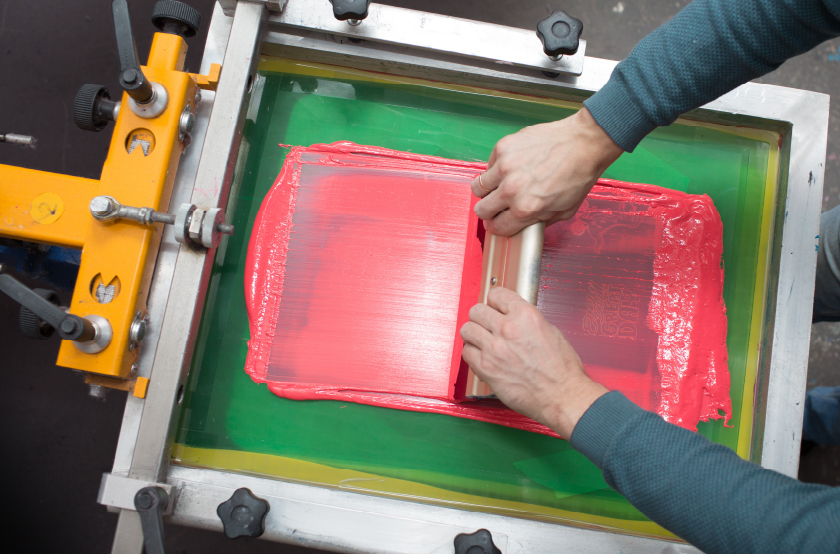As is the case for any business, the goal of running a screen-printing business is to make a profit. Unfortunately, there is no all-in-one cost calculator that encompasses all the factors involved in running your business.
However, here is an example of a simplified formula:
Revenue (Printing Fees + Raw Materials and Markup)
– Cost of Goods Sold (Raw Materials Costs, i.e., garments, inks, film, labor, etc.)
= Gross Profit
– Overhead and Operational Expenses
= Net Profit
Keep reading to learn more about the parts of this formula and how to set prices for complex print jobs.
Materials Markup
Among the myriad of other operational expenses to run a business, it takes time and resources to source and buy materials. Marking up materials and services is part of the profitability equation. A useful screen printing industry standard is to markup items by at least 50% of your cost. If your garment costs $1.00, you would simply divide by 0.50 to calculate your margin goal of 50%. This means the component price of the shirt alone would be $2.00.
If the order is large, you have room to negotiate, but you need to understand the margin. Many people think that $1.50 would have been a 50% margin. Unfortunately, it is not. $1.00 divided by $1.50 equals 0.67. This means that your cost is 67% of your component selling price, or 33% margin.
This is a common mistake in calculating margin and, unfortunately, a dangerous mistake. Granted, none of this takes into account competitive pressures. So more than just numbers go into these calculations. Outside factors carry a lot of influence. Remember, though, that the point of all of this is to make money. What you do not make on one deal, you must make up on another. It is more practical to make money on them all.

Material Costs
No two print jobs are the same (most of the time). Different customers will have different expectations and needs, and it’s up to your shop to have a system in place to calculate your costs depending on how specific a job may be. Evaluating factors like set-up time, the number of ink colors, type of garment, artwork, garment sizes, type of ink, and design placement are critical to getting your desired profit.
Assessing Job Difficulty
Simple
Some qualifiers for a simple job include having print-ready artwork, less than four colors, and if it’s a reprint job with minimal changes. Regardless, while the number of colors influences the set-up times, a reprint will require you to store and locate screens and set up the job again. All of this requires labor in storing, finding, and re-setting-up and job. It also involved space for which you pay rent to store the exposed frames. It remains simple but has hidden costs. Nevertheless, they should be considered income generating, and while having jobs like these may not be exciting or generate a lot of revenue, they can be very profitable.
Complex
Complex jobs can be fun, challenging, frustrating, and profitable. There will be customers who require artwork revisions, more colors, finer details, and unique materials. Some may also have unrealistic expectations, especially for deadlines. These things all have associated costs, whether they be labor, opportunity costs, or the like, and they must be tracked to maximize profit. Additionally, there is little room for experimentation or errors during these runs. The greater the risk, the greater the rewards, but the likelihood of trial and error should be considered. If they are likely, your shop deserves compensation for them nonetheless. Considering the amount of time and labor spent working more complex jobs, a higher print fee may be required to cover the costs associated with the complexity of the work.
Labor and Overhead Costs
Time is money! Your time and your staff’s time are valuable. Not only do you need to pay your employees, but also account for benefits, holidays, and taxes.
Consider, as well, the overhead costs of insurance, rent, supplies, and other utilities needed to operate your screen printing business. These overhead costs will need to be included in your pricing for your business to succeed.
The hours you spend working are divided into your monthly fixed overhead costs, including variable overhead costs, plus your labor costs, which is mostly how one determines his real burdened labor rate.
Knowing your burdened rate will help you apply the correct labor costs to your work.
An Overview of Printing Costs
Our infographic below reviews all of the elements influencing your desired profit. Consider each one and organize a system for your screen printing business.

How You Can Earn More with EXILE
If you want to save on labor and overhead expenses, consider automating your pre-press process with EXILE Technologies.
Our computer-to-screen equipment assists in automating segments of the prepress process and increases your shop’s efficiency. EXILE Technologies also offers a knowledgeable staff ready and willing to help with any questions and issues you may experience. We look forward to becoming your preferred partner for innovative pre-press solutions!



